Key takeaways:
- Choosing the right tour time involves understanding industry trends, audience availability, and local events to ensure a successful turnout.
- Timing can significantly impact a tour’s success, including considerations for seasonal trends, audience schedule conflicts, and external factors like weather.
- Engaging with fans through social media insights can help gauge their availability and preferences, enhancing concert attendance.
- Balancing personal preferences with audience needs, while being mindful of local happenings, plays a crucial role in effective tour scheduling.
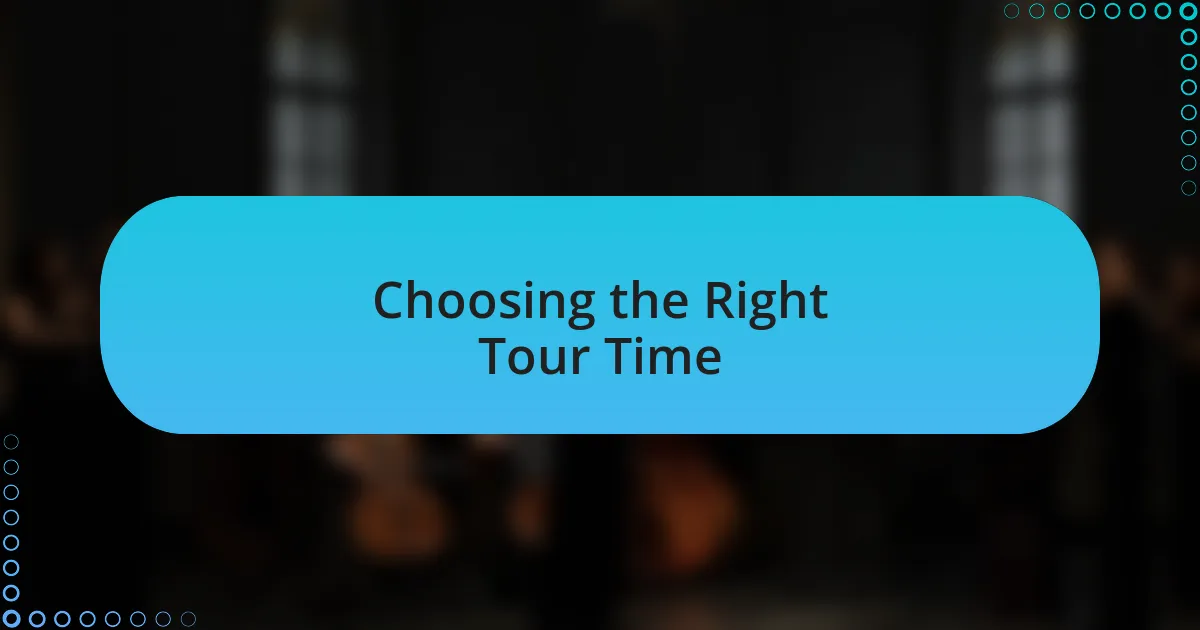
Choosing the Right Tour Time
Timing a tour is one of those decisions that feels both exhilarating and daunting. I remember the time we were considering a summer tour versus a fall release—while summer holds a fun vibe, the competition is fierce. I often wonder, do we want to stand out or blend in? Choosing a season takes more than just preference; it’s about understanding the industry rhythm and audience expectations.
Then there’s the question of aligning with holidays or local events. I once scheduled shows around a city’s music festival, thinking it would boost attendance. It turned out to be a double-edged sword—while the vibe was electric, our fans were easily distracted by so many options. Have you ever thought about how local culture can affect your schedule? It’s vital to tap into the local heartbeat to ensure your timing resonates.
Additionally, I find that considering the band’s own cycle matters as well. There was a time when we were exhausted after several back-to-back gigs, and I realized it affected our performance. It taught me that the right time isn’t just about the perfect market conditions, but also about our readiness to give our best show. Have you ever pushed your limits too far? Finding a balance can be the difference between a memorable tour and a missed opportunity.
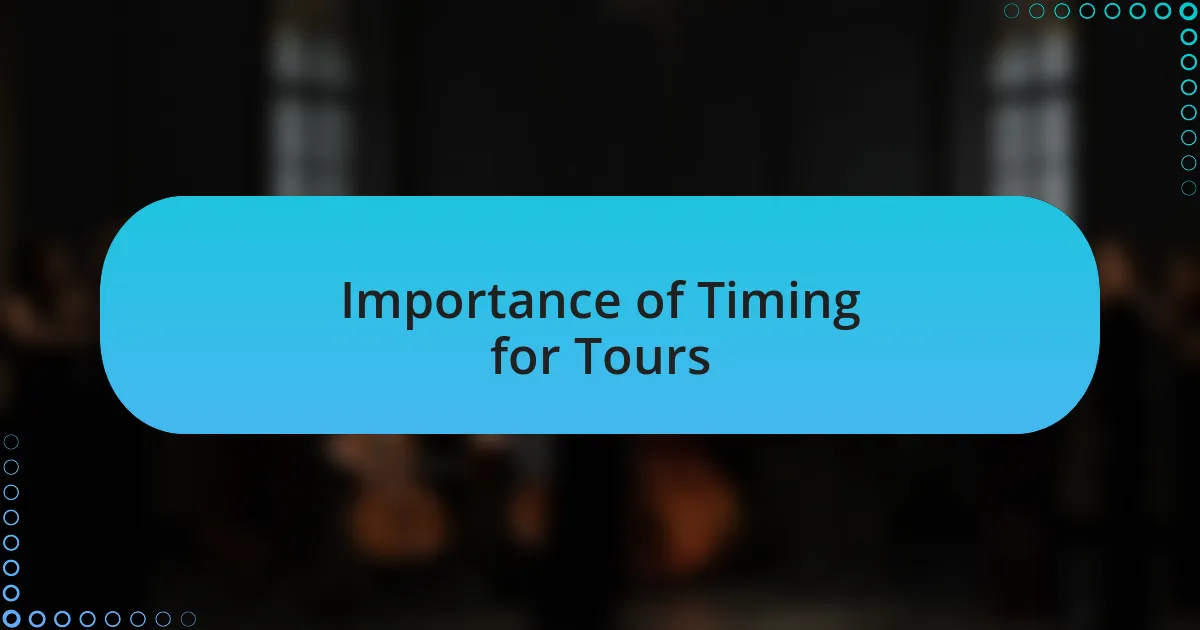
Importance of Timing for Tours
Timing can make or break a tour, and I’ve experienced this firsthand. For instance, I once planned a winter tour, anticipating cozy indoor venues and eager fans. Instead, we faced winter storms that kept audiences at home. It made me realize how external factors can influence attendance. Have you ever had plans thwarted by something outside your control? It taught me to always have a backup plan.
Another notable moment came when we decided to launch an album just before the holiday season. The excitement was palpable, but as shows drew closer, I noticed people were more focused on holiday shopping and family commitments than attending concerts. This made me rethink our timing strategy. Are we truly engaging with our audience when they’re preoccupied?
I’ve come to understand that timing also involves personal growth. There was a phase when I was burning out, and we considered touring during that period. Thankfully, we paused to recharge, which ultimately led to a more vibrant and authentic performance. In what ways can our own well-being dictate the success of a tour? Recognizing this connection was a game-changer for us.
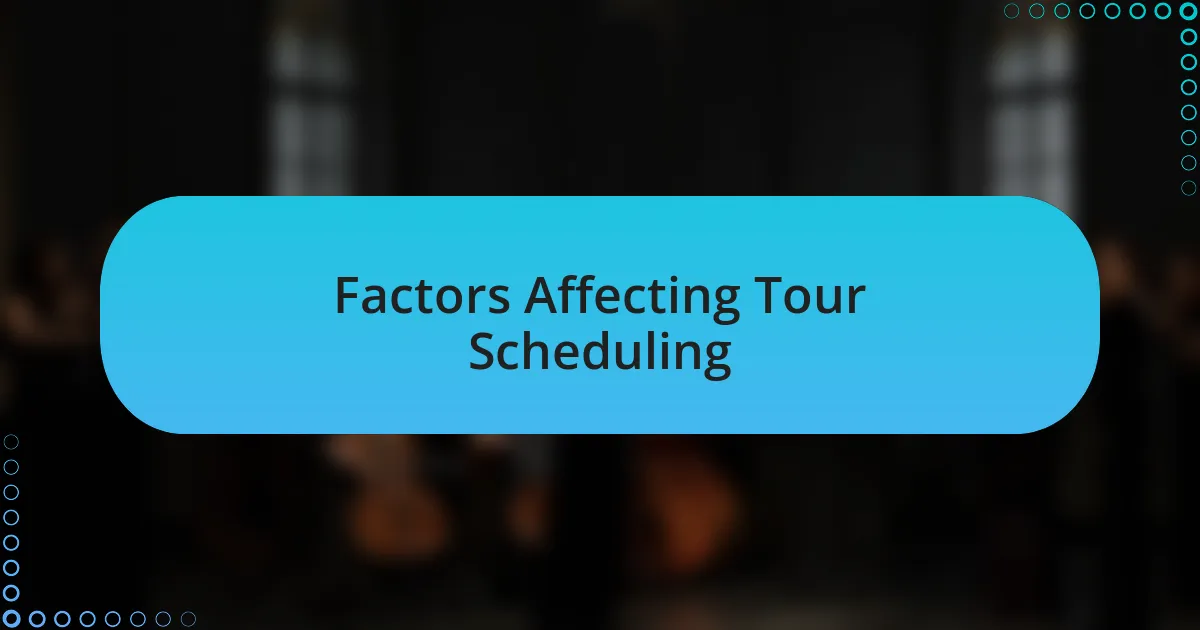
Factors Affecting Tour Scheduling
When it comes to scheduling a tour, one significant factor is the season. I recall a summer tour where we thought the warm weather would draw in crowds, only to find many people were away on vacation. The lesson? Understanding your audience’s lifestyle and typical behaviors during different times of the year is crucial. Have you ever thought about how seasonal trends impact attendance?
Another element I often consider is regional events. Once, we planned a show near a major annual festival, expecting it to boost our audience. Instead, we found our audience fragmented, with many fans opting for the festival instead. This experience reinforced the need to research local calendars and community activities to find the right window for our concerts. How well can we adapt our plans to external distractions?
Travel logistics also play a vital role in tour scheduling. I vividly remember a time when unexpected road closures forced us to change our route last minute. It not only added stress but also impacted our performance prep. This taught me the importance of having flexible schedules and backup plans to accommodate unforeseen circumstances. How can we remain adaptable while maintaining our creative momentum?
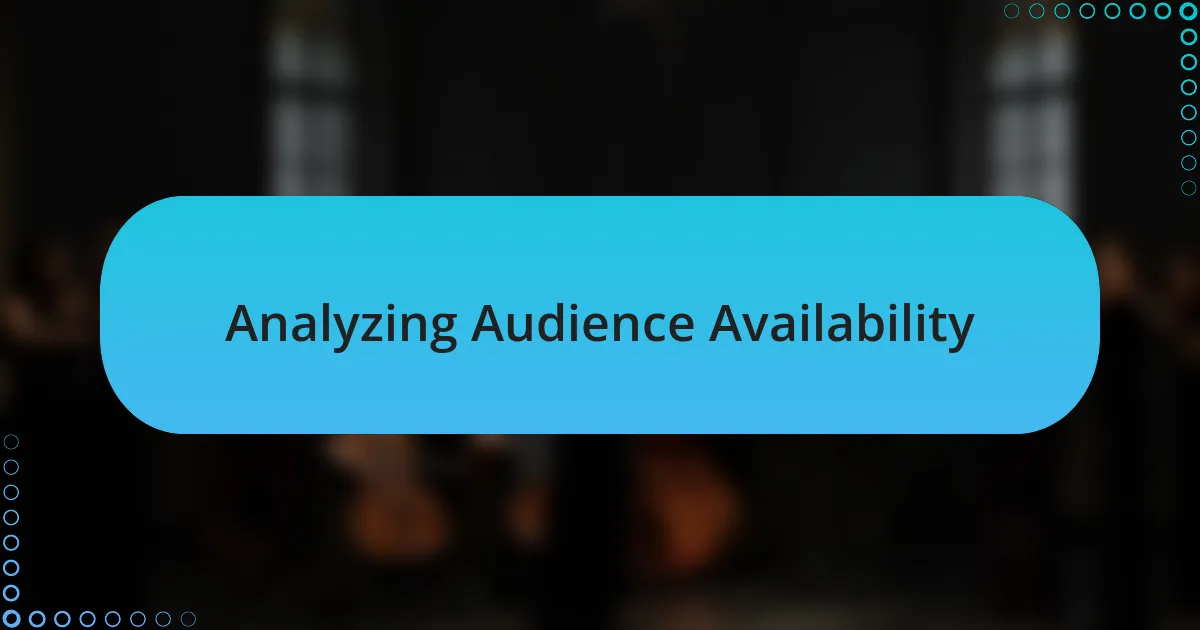
Analyzing Audience Availability
Understanding audience availability means more than just picking a date; it involves diving deep into when your fans are actually free. I remember a show I planned on a weekday evening, thinking it would work perfectly only to realize my audience was tied up with work commitments. It made me question, are we really in tune with our fan’s schedules?
Local demographics also play a huge role in audience availability. Once, while touring a university town, I scheduled a show during finals week. I was convinced the energy of students cramming for exams would draw a crowd. However, the reality hit hard: my audience was too busy stressing over grades to make it to the venue. It’s moments like these that press upon me the importance of knowing not just who my fans are, but also what’s happening in their lives.
Finally, utilizing social media insights can be a game changer when it comes to gauging audience availability. I often post polls or questions related to potential tour dates, and the feedback is invaluable. Have you ever thought about how directly asking your audience could lead to higher turnout? That interaction not only reinforces connections but guides you in making decisions that truly resonate with their schedules.
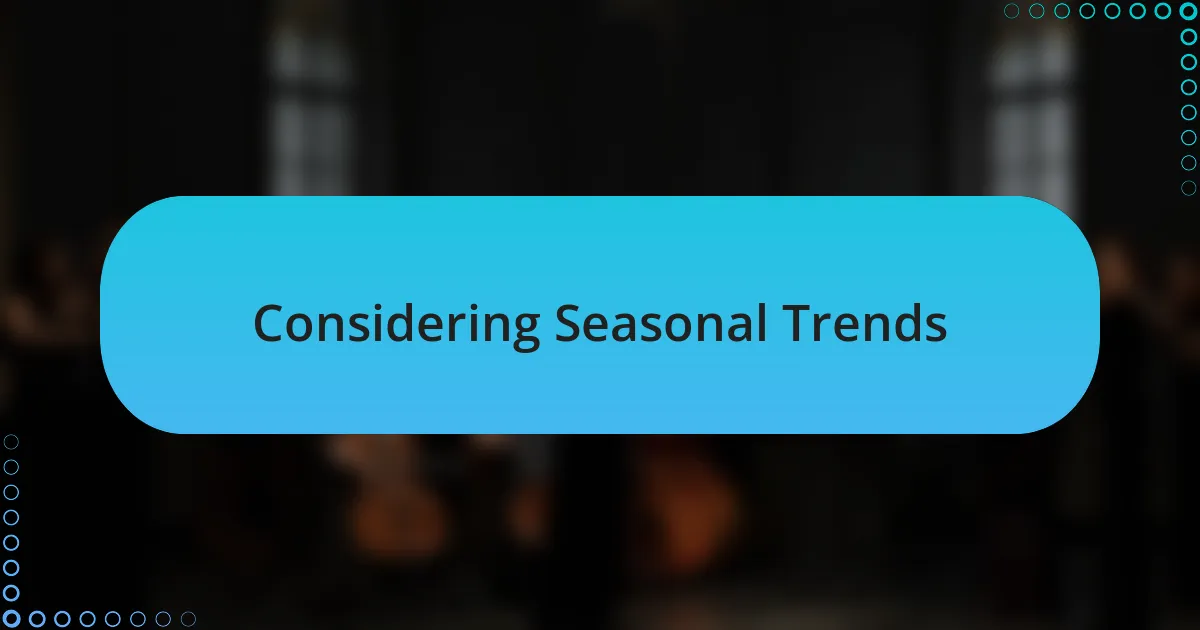
Considering Seasonal Trends
When I plan a tour, I can’t ignore the impact of seasonal trends. For instance, summer always feels like a prime time for outdoor concerts, but I must consider that many fans might be on vacation. One summer, I scheduled a gig during a popular local festival, thinking it would boost attendance. Instead, I found a fraction of my usual crowd because they were busy enjoying the festivities elsewhere. Have you ever thought about how certain seasons pull your audience in different directions?
In contrast, I’ve noticed a spike in audience engagement during the holiday season. Last year, I planned a special show around Thanksgiving, and the turnout exceeded my expectations. It was as if the warm atmosphere and holiday spirit pulled everyone together, creating a sense of community that was palpable. Understanding these seasonal nuances has taught me that timing can greatly enhance the connection between artists and their audiences.
Additionally, the weather plays a critical role in shaping my decisions. During winter months, outdoor venues can be a gamble, while intimate indoor settings can create an inviting ambiance. I remember one chilly December evening where we opted for a cozy venue, and the intimacy of that space turned a simple performance into a memorable experience. Isn’t it fascinating how a change in season can completely transform the vibe of a concert?
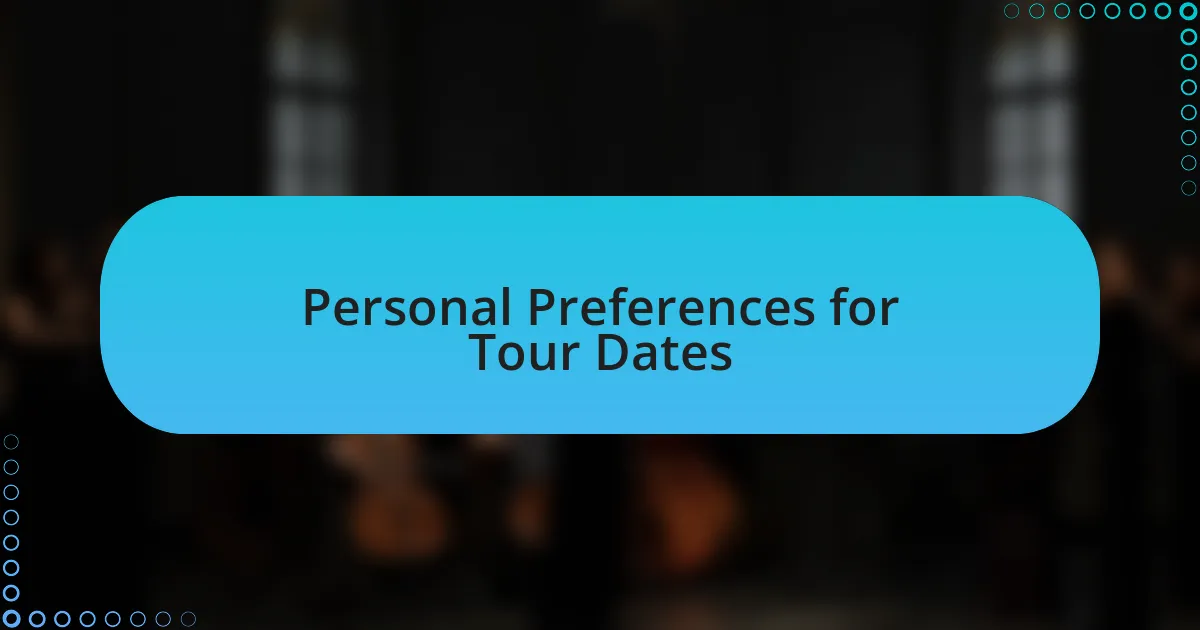
Personal Preferences for Tour Dates
There’s something special about choosing tour dates that speak to my personal preferences and the connection I feel with my audience. I’ve found that mid-week shows, like a Wednesday night, can yield surprising turnout; they often attract more dedicated fans who might prefer an intimate setting over the weekend chaos. I remember a show I held in a small venue on a Wednesday, and the energy in the room was electric. It felt like we were all in on a secret, sharing an experience that wasn’t about the crowd size but the quality of connection.
I also pay close attention to what’s happening in the local scene around the dates I choose. There was a time when I scheduled a show during a significant sporting event, thinking it would draw in fans. Instead, I was met with a nearly empty venue. It made me realize how important it is to team up the music with the vibe of the community, ensuring my fans can prioritize the concert amongst their other passions. Have you ever been torn between two great experiences happening at the same time?
Ultimately, finding the right balance between my preferences and my audience’s needs significantly impacts my tour planning. I cherish the moments when I look out into the crowd and see familiar faces who have come because they connect deeply with the music. There’s nothing quite like that shared energy; it reinforces for me that I not only pick tour dates based on logistics but also based on what resonates with the heart of our community. How do you choose your moments to shine?
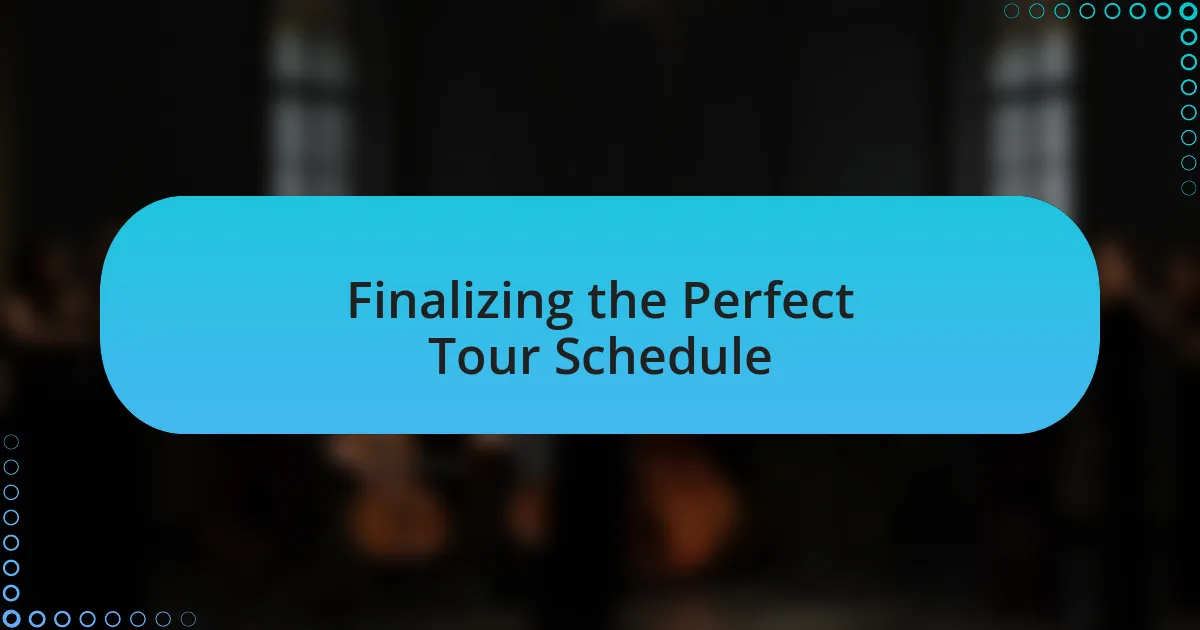
Finalizing the Perfect Tour Schedule
When I sit down to finalize a tour schedule, I often reflect on the best seasons for live music. For instance, I’ve noticed that late spring and early fall tend to bring in larger crowds, as people are often looking for ways to celebrate the changing seasons. One memorable tour stop in the fall felt particularly magical, with leaves turning and the air crisp – that vibrant atmosphere added an extra layer of enjoyment to the concert for both my band and the audience.
Balancing my musical commitments with local events has taught me a valuable lesson. I once booked a show close to a major music festival, thinking we could benefit from the buzz. It turned out to be a miscalculation; the festival attracted the crowds, leaving our venue quieter than anticipated. Have you ever overlooked a detail that ended up being crucial? That experience reinforced my understanding of the importance of timing and awareness of the local calendar when securing tour dates.
Lastly, I’ve found that establishing a rhythm for our tours helps maintain momentum. After a few successful runs, I learned to schedule breaks between tours so the excitement can build while giving the band a chance to recharge. One year, I experimented with a longer gap, and when we returned, the fans welcomed us with an enthusiasm that took my breath away. Have you ever thought about how a little anticipation can transform an experience? That’s the magic I strive for when finalizing our tour schedule.